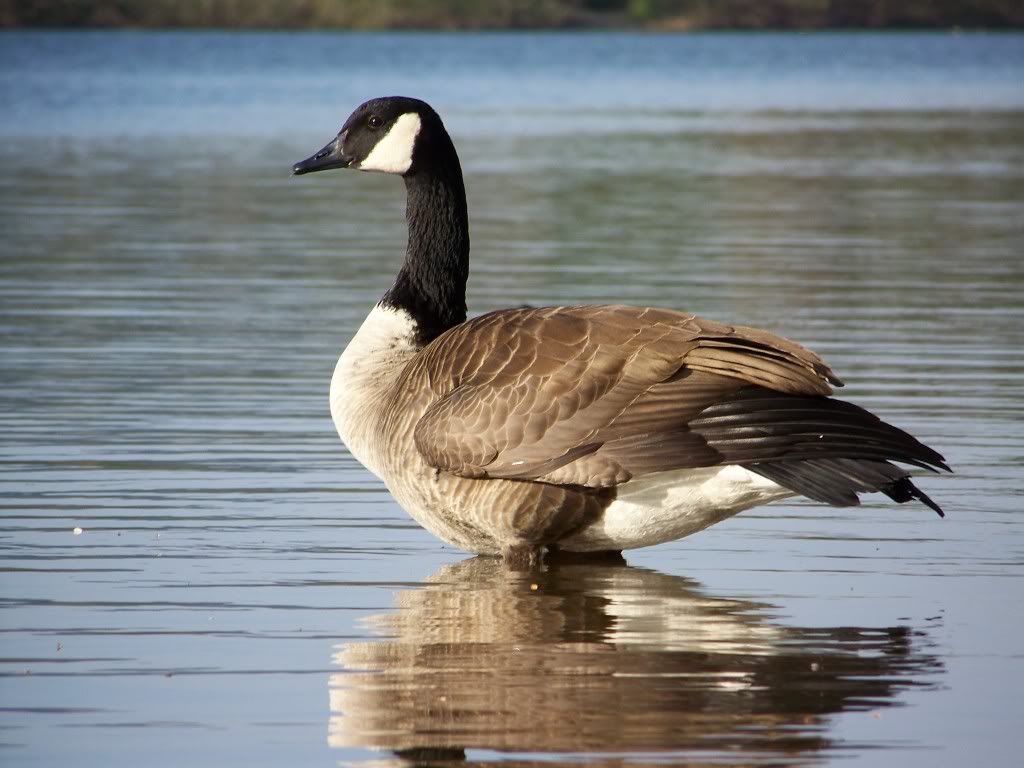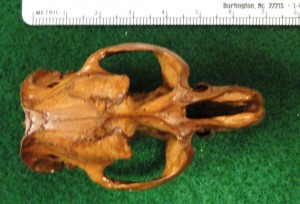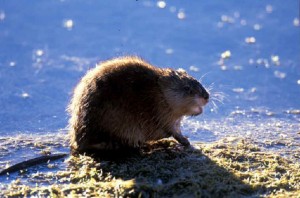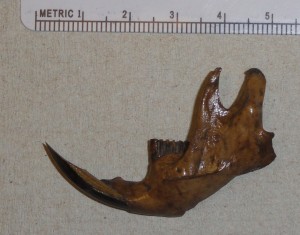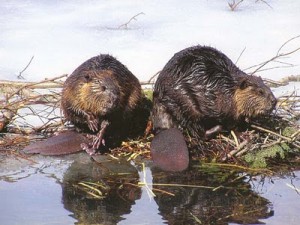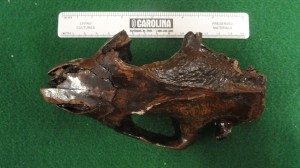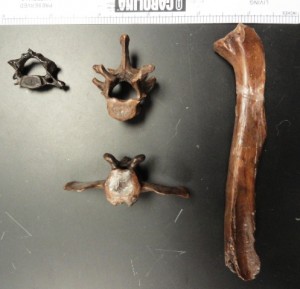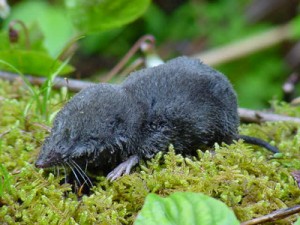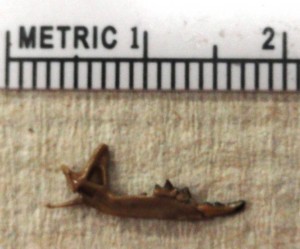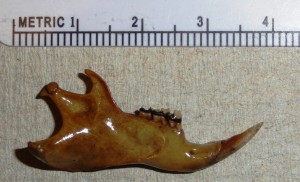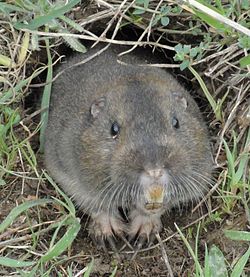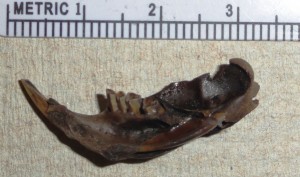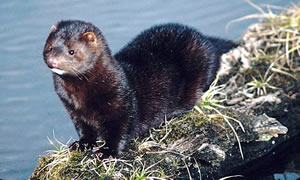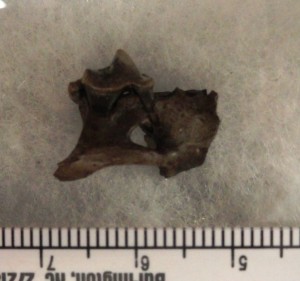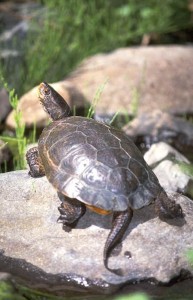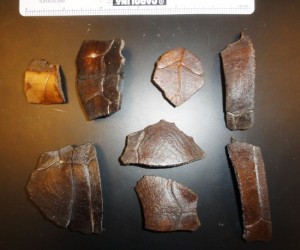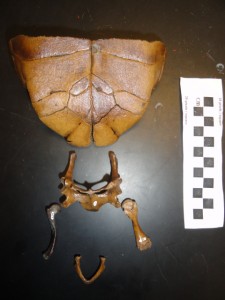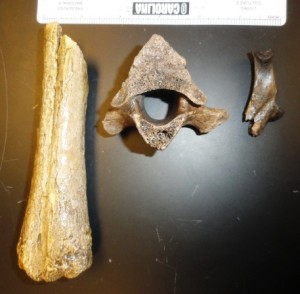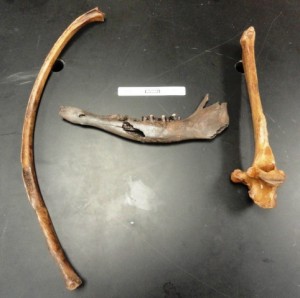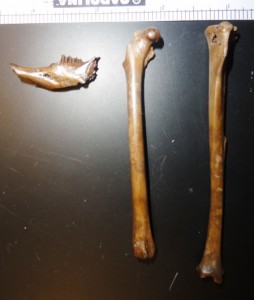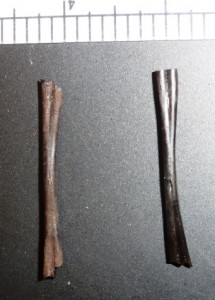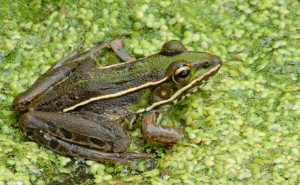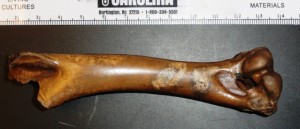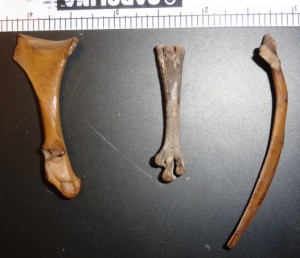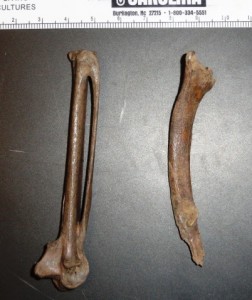Woodburn Animals
Over the years, many bones and fragments of bones have been found in the soil deposits at Woodburn High School. Most of the bones found in the digs belong to animals that are commonly found in wetland/bog environments. Below is a list of animals found so far, with a brief description.
Muskrat (Ondatra zibethicus)
Muskrat bones are the most common bones found in the Woodburn digs. Today, Muskrats are found in wetlands, marshlands, rivers, lakes, or ponds. They can be found throughout North America.
An adult Muskrat is between 15-20 inches (40-70 cm) in length and can weigh around 3-5 lbs (1-3 kg). They have short, thick, dark brown or black fur, but as they get older their fur turns partly grey; they have two layers of fur that protect them from the cold water. They also have a long tail which is not covered with fur but with scales which are slightly flattened vertically which makes it easier for them to swim.
Muskrats eat mainly aquatic vegetation like cattails, but sometimes will eat small animals like crayfish, frogs, and fish. The main predators of Muskrats are animals like mink, coyotes, wolves, large owls and hawks.
The information above was provided by Ana Lopez a senior from WeBSS 2011/12
Beaver (Castor canadensis)
A Beaver can weigh between 35Lbs to 60 Lbs. Beavers measure about 2 feet long (not including their tails). They have two cutting teeth that continue to grow throughout their life (they are used to cut trees); they have a total of 20 teeth.
All beavers work together to build their homes called a lodge. Their homes measure from 3 to 6 ft. high and about 7 ft. across; they build up to 2 rooms. One is a living room (above the water) which they use to sleep, and the other one is the storage room (under water), where food is kept. Beavers are found near running water with many trees along its banks.
Beavers are herbivores and prefer to eat leaves, bark of trees like willows and birch. They also eat twigs, roots, berries, and other aquatic plants. Beavers are hunted by bears, wolves, and humans.
The information above was provided by Ana Lopez a senior from WeBSS 2011/12
Water Shrew (Sorex spp.)
The smallest bones found in the soil deposits belong to the Water Shrew. It is a small animal that has a total length of 4-6 inches (120-140 mm) and weight of ½ lbs (12-18 grams). They eat mostly aquatic insects, but will also eat other invertebrates, including small fish and amphibians when available. Predators include snakes, weasels, fish, owls, hawks, and large frogs.
Water Shrews are active throughout the day in every season. They hunt under and on top of water and may be seen running across water surfaces which they can do because of webbing on their hind feet. Water Shrews live along streams, lakes ponds, and other aquatic habitats. They are rarely found far from water.
The above information was provided by Rubi Tapia, a senior at WeBSS 2011/12.
Western Grey Squirrel (Sciurus griseus)
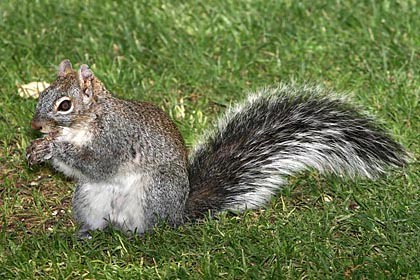
The Western Grey Squirrel body measures 18-24 inches (45-60 mm) in total length, and can weigh between 5-6 lbs (350-950 grams). They can be found in the Washington, Oregon, California, and a small part of Nevada.
They live in woodland and coniferous forests. Western Grey Squirrels are eaten by owls, snakes, bobcats, mountain lions, and eagles. They feed largely on nuts and acorns. They are also known to eat berries, fungus, bark, sap and insects.
The information above was provided by Violetta Aguilar a Senior at WeBSS 6/7/12
Sandhill Crane (Grus canadensis)
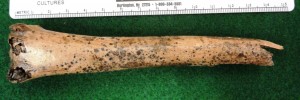
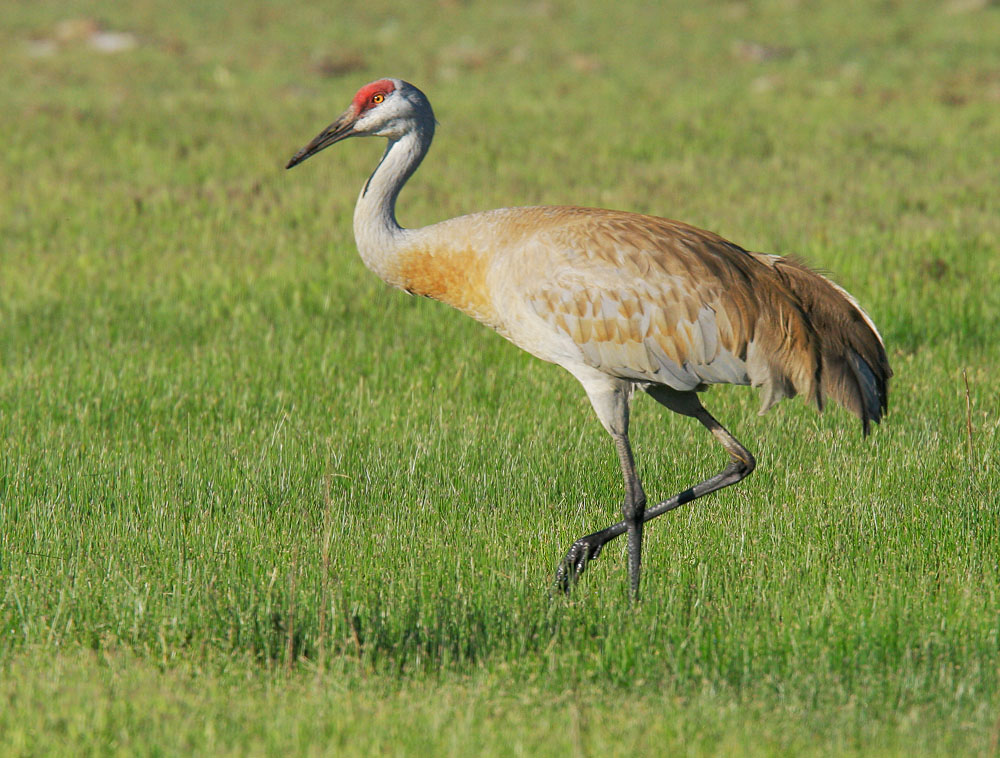
The Sanhill Crane lives in open grasslands, meadows, and wet lands. They are a very large bird with long necks and legs. Along with a gray body that may be stained reddish they have a red forehead. The Sandhill Crane is an omnivore. Their diet includes grains and seeds, some insects, other invertebrates and small vertebrates. Even though the Sandhill Cranes are hunted by foxes, coyotes, wolves, and birds of prey.
The information above was provided by Lupe Amaya, Agustin Perez, and Angelica Ruiz, juniors from WAAST 1/10/13
Pocket Gopher (Thomomys spp.)
Pocket Gophers are medium-sized rodents ranging from about 5-10 inches (13 to 36 cm) long. Adult males are larger than adult females. Pocket Gophers habitat is grassland areas that have soft soil for digging. They live mostly underground and are rarely seen on the surface.
Pocket Gophers eat roots, tubers, bulbs, grass, and nuts. Numerous predators eat Pocket Gophers; some of the predators pursue the gopher in its tunneling system such as weasels, perhaps spotted skunks, and several types of snakes. Other mammalian predators include coyotes, foxes, and bobcats.
The above information was provided by Jose Becerra a freshman from WeBSS 2011/12
American Mink (Neovision vision)
The size of the Mink for males is 13-18 inches (34-45cm) in the body length, while females are 12-15 inches (31-37.5 cm) long. The habitat of the Mink is near water and is seldom found far from riverbanks, lakes and marshes. They also tend to follow streams and ditches. The Mink is slender with a tail that is about a third of its body size. It has fur that is glossy and thick, it can vary in color but is usually dark brown or black and during the winter it gets darker. Its fur is very soft and thick, it is also covered with an oily guard that makes the Mink’s coat waterproof. It has short stubby legs and its feet are slightly webbed. The Mink has a long neck; small ears and eyes and a long thick tail.
The mink preys on fish, muskrats and frogs. During the summer 50% of their diet is aquatic animals. During the winter they eat less aquatic food and more muskrats and occasionally rabbits. The Mink’s predators consist on bobcats, coyotes, great horned owls and wolves. Minks are very territorial, they will fight for their territory.
The following information was provided by Dagoberto Diaz, a freshman from WeBSS 2011/12 and Ana Garcia a junior at WeBSS 2001/12
Pond Turtle (Actinemys spp.)
The size of this Pond turtles when they are young they are about 5-7 inches in length and when adult size they are 6 to 8 inches long. Pond turtles live in ponds where there is a lot of algae and other aquatic plants.
The things that hunt the pond turtles are fish such as bass and pike. They will eat turtle hatching, Frogs and snakes will as well. Mature frogs will eat small fresh water turtles, and mammals prey on turtles too. Pond turtles will also eat worms, crayfish and insects.
The above information was provided by Sergi Yakis a junior at WeBSS 2011/12
Elk (Cervus canadensis)

Elk and other members of the deer family belong to a group of animals called ungulates, the Latin word for “hoof.” Elk gather in herds and were common across North America in the past, but now are concentrated in the western, mountainous portions of the continent.
Elk eat different kinds of grass, like wheatgrass, clover, sedge and mountain brome. The animals that eat elk are wolves, black bears, and cougars. Elk prefer open woodlands and avoid dense unbroken forests. Elk can be found in coniferous swamps, clear cuts, aspen-hardwood forests, and coniferous-hardwood forests. The size of an elk is 4 to 5 feet tall weight is 325 to 1,000 lbs.
The following information was provided by Daniel Gonzalez, a junior at WeBSS 1/10/13.
Ancient Bison (Bison antiquus)
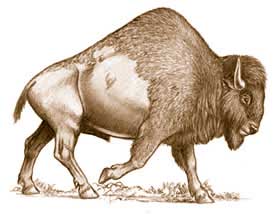
The Ancient Bison was known to inhabit open woodlands or savannas. Their ancestors migrated from Siberia into Alaska over 100,000 years ago and they inhabited most parts of North America until the end of Pleistocene. These bison preferred to be in small groups or herds with stronger dominance behavior by males.
Ancient Bison shared the grassland environments with horses, camels, giant ground sloths, and mammoths, so they weren’t very territorial. Their diet included feeding on small trees and shrubs. They were more of a grazer and did some browsing.
Modern Bison have nothing compared to the Ancient Bison when it comes to their size. Ancient Bison are 7-9 ft. tall and 15 ft. long. They weigh at about 2,000-3,000 lbs. All bison have 32 teeth, with size being the only difference between the species. Besides the nearly complete skeleton found in 2008, many bones from other bison have been found.
The following information was provided by Alejandro Rodriguez Rodriguez a senior from WeBSS 2012/13.
Rabbitt (Sylvilagus spp.)
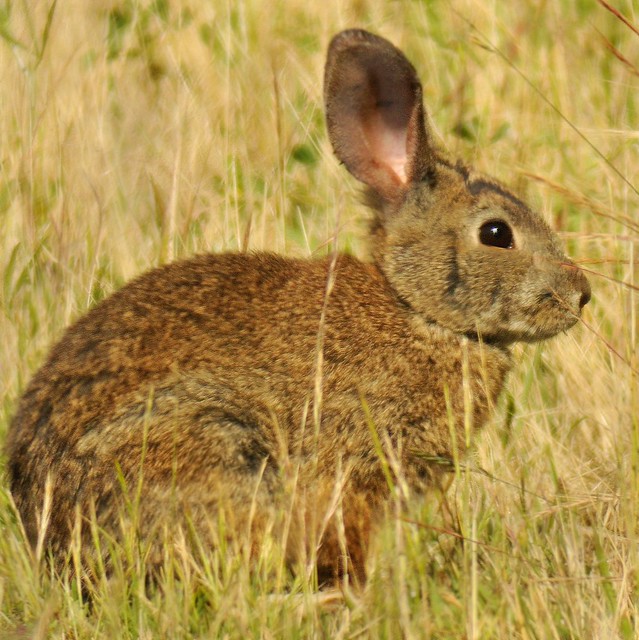
Well known habitats for the Western Rabbits are brush and grass covered land areas. The size of a Western Rabbit or also known as a Brush Rabbit for an adult runs from 10-14 inches long. The vegetation for the Western Rabbits are mainly grass, forbs, and green clovers. On occasion these rabbits will eat berries or will look into bushes to find there next meal. Predators known to the Western Rabbits are animals such as cougars, coyotes, bobcats, weasels, and snakes.
The above information was provided by Jessylynn Bustamante a freshman at WeBSS 2013/14
Leopard frog (Rana pipens)
Wild Turkey (Meleagris gallopavo)

Northern Pintail (Anas acuta)
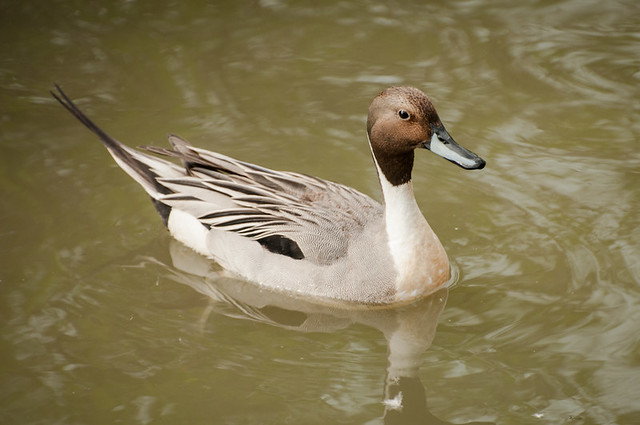
The Northern Pintail is 23 to 30 inches (51 to 63.5 cm) long and weighs around 1 to 2.5 lbs. The Northern Pintails habitat is in open country with shallow wetlands and low vegetation, including marshes, ponds, lakes, and rivers. Mostly the pintails eat in the evening. They mostly eat seed of aquatic plants like pond weeds, sedges, and grasses. Their population is affected by predators such as bobcats, coyotes, and foxes.
The above information was provided by Gustavo Lopez a freshman at WeBSS 2013/14
Canada Goose (Branta canadensis)
